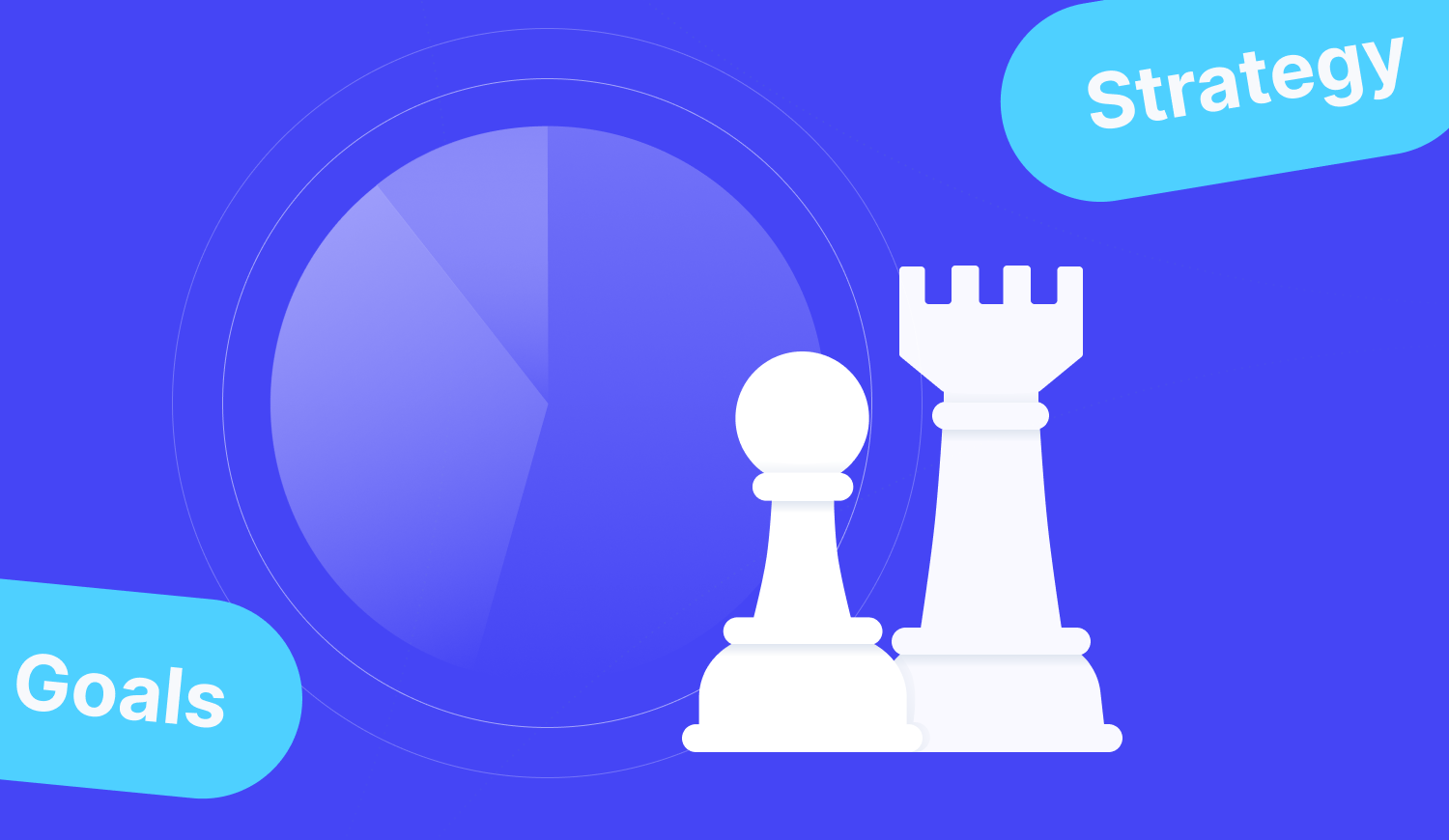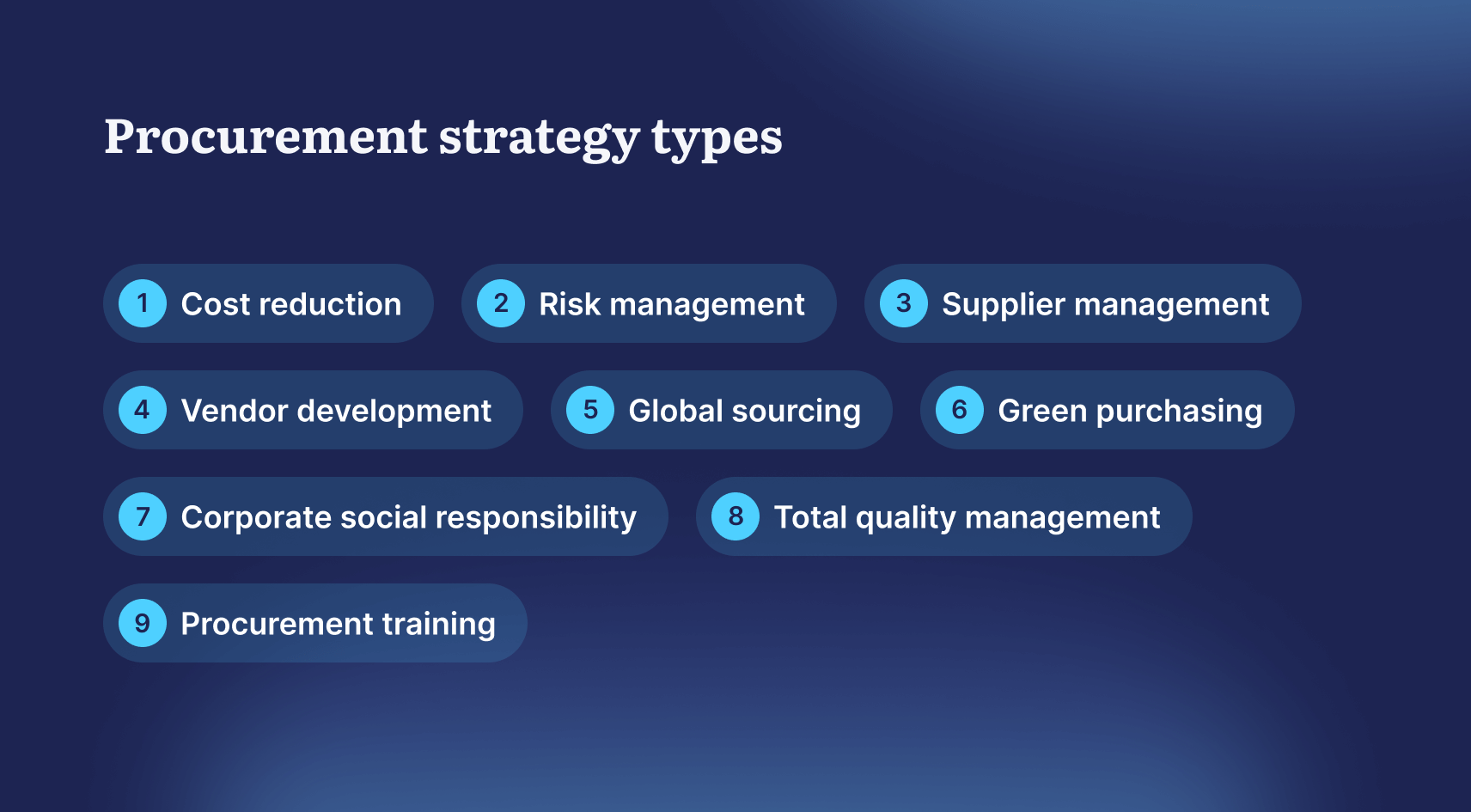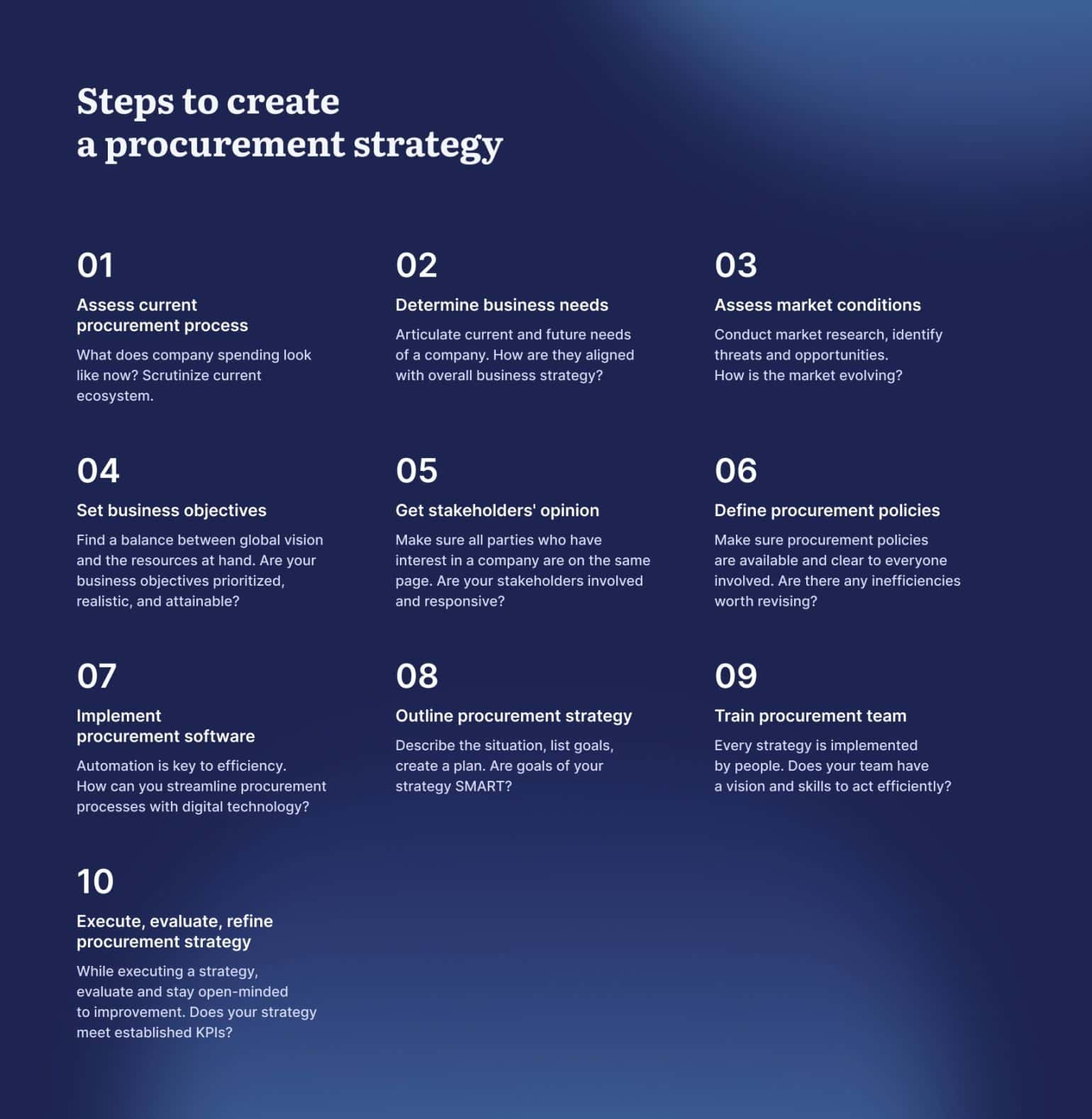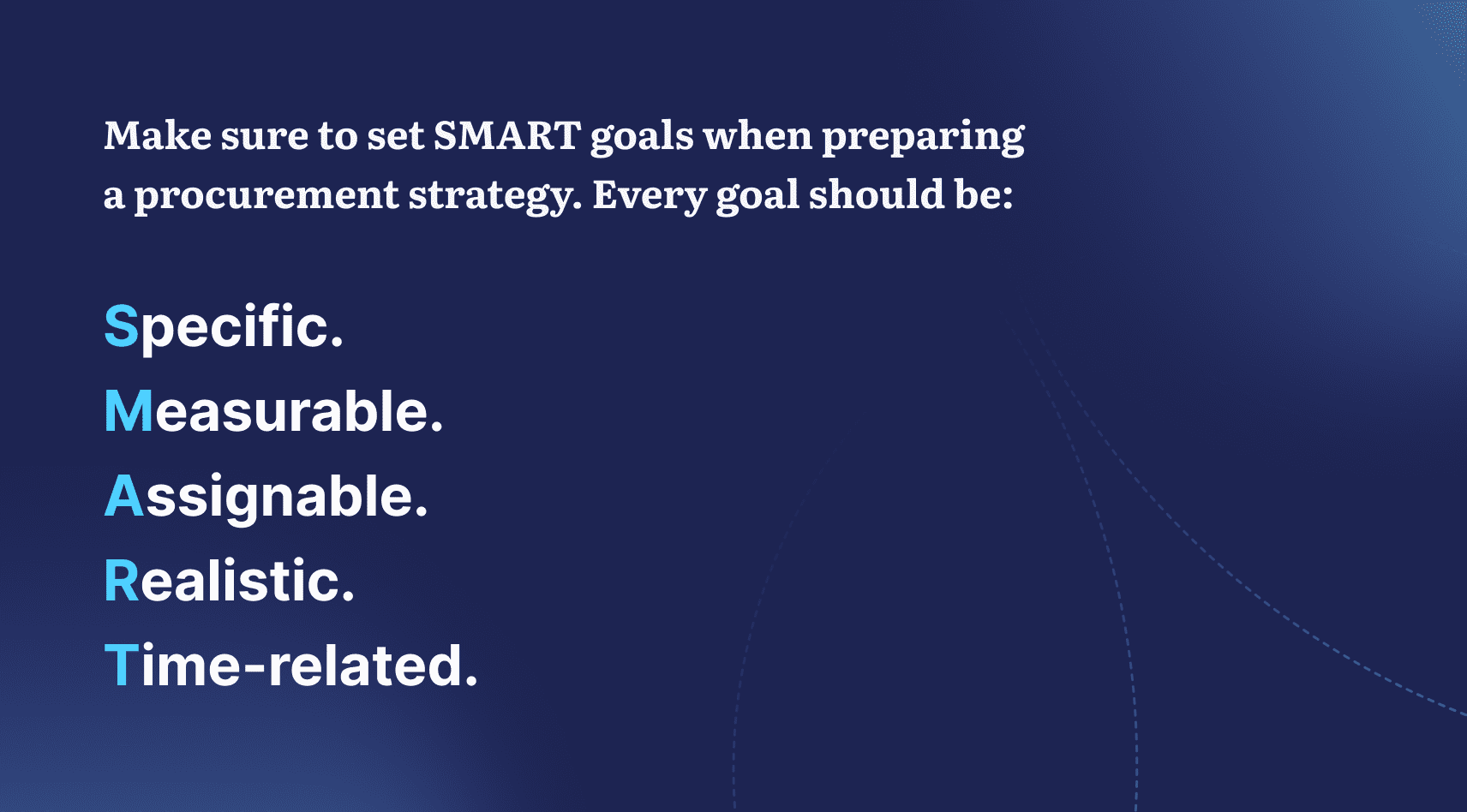
13 min read
Procurement Strategy. How to Get it Right? [Guide + Template]
When procurement strategy is aligned with the business goals, expect up to 3.8x higher ROI. Read on strategy types and follow a step-by-step template to develop one.
Strategic Procurement Helps a Business Unleash its Potential
As The Hackett Group discovered, approaching procurement strategically with specific business goals in mind helps achieve a significantly higher ROI.
A procurement team, if perceived as a partner rather than an executor by internal stakeholders when defining and executing the company's business strategy, proves to deliver.
Operational efficiency and cost reduction are among the top procurement priorities for CPOs, according to Deloitte.
To optimize OPEX, to understand, analyze and project a company's cash flow, CPOs introduce procurement strategies.
In this article, we are covering the basics of strategic procurement.
- What is a procurement strategy?
- What is its purpose?
- Main types of procurement strategies
- Steps to develop a strategy
- Procurement strategy examples and template to create one
- Why is procurement strategy important
- FAQs
What is a Procurement Strategy?
The term procurement strategy refers to a long-term plan to build strategic relationships with competitive suppliers to acquire the necessary goods and services of the best quality in a specific cost range and have them delivered on time.
A procurement strategy defines how purchasing decisions are made. It’s an overarching term that encompasses various processes of a procurement cycle.
Winning procurement strategies outline budgets and actionable steps based on internal analysis and external observations.
Strategic procurement helps to determine which goods or services to select, from which suppliers, and how much to pay based on data about vendors, market, pricing, and other vital factors.
What is the Purpose of a Procurement Strategy?
Procurement strategy reflects the company's vision, goals, and objectives and provides a set of methods and practices to align with them.
It’s a pillar of production, fundamental for ensuring the best quality of its output with optimal use of resources.
Strategic procurement allows obtaining well-structured and relevant data, which is indispensable for prioritizing purchases and balancing the quality and price of goods or services.
In general, effective procurement strategies help companies introduce and promote their best practices of minimizing costs while maximizing quality and ensuring that the right products are delivered on time.
Selecting Relevant Procurement Strategy
Every company is unique and requires implementing tailored procurement strategies.
However, several types of procurement strategies can be adjusted and adopted by organizations of any kind.

Cost Reduction
The most common procurement strategy focused on increasing profits through recognizing saving opportunities and decreasing the total cost of ownership (TCO).
Cost savings constitute an important strategic part of a good procurement strategy on a tight budget.
Cost reduction is a complex and multi-layered process, influenced by various decisions made across the company's departments on many hierarchy levels.
It involves negotiating with suppliers, adjusting internal administrative and operational expenses, and automation.
Risk Management
Risk management strategy minimizes the impact of unfortunate events on the procurement process.
Following this strategy, an organization prepares to compensate for any supply chain risk.
This strategy allows a company to develop appropriate responses to potential risks. Core elements of risk management strategy include the following steps:
- Identify the risk events and their relationships;
- Understand their origin, nature, and possible impact;
- Prioritize based on the force of impact;
- Monitor to be prepared;
- Mitigate the risk to prepare and lessen the impact on business;
- Communicate risk management practices to teams involved in procurement.
Supplier Management, Optimization, and Relationship Building
The strategy is about managing suppliers and relationships that the company builds with partners.
It means that the company chooses an optimum mix of partners who would offer the best cost of goods or services and ensure smooth cooperation.
This type of procurement strategy implies that any supplier that does not meet the company's standards should be taken out of the supply chain.
The company might conclude that it’s necessary to alter the supplier base and increase or decrease its diversity to achieve a specific procurement goal.
Vendor Development
Depending on the nature of cooperation with the specific vendors and the scale and importance of goods or services they provide, it might be necessary to invest in developing such vendors.
This procurement strategy is based on mutual partnerships. Through close cooperation, feedback, and suggestions, a client helps a vendor develop a way to offer better or cheaper products, which benefits both parties.
This strategy is even more relevant when a purchasing company depends upon one supplier for a specific product, and the supplier cannot meet the required standards.
Then, the company might assist the supplier in implementing processes to achieve required quality levels.
A vendor development strategy is implemented for limited suppliers selection or highly unique goods. In that case, efficient vendors are vital for achieving strategic goals.
Global Sourcing
The strategy refers to the efficient sourcing of goods and services across the globe.
Its objective is to discover and utilize cost-efficient sourcing possibilities in a specific country or part of the world where required goods can be produced more economically.
With the increasing significance of the international economy, companies are forced to explore alternative source markets to maximize profits.
Global sourcing brings substantial benefits such as an opportunity to lower costs and increase the volume of goods and services produced and offered.
It’s also a possibility to use international expertise and technology that may be unavailable in the company's home country.
However, adopting the global sourcing strategy, one should be aware of the severe challenges it implies:
- The difficulty of monitoring the production process, quality levels, and costs;
- Complex supply chain;
- Long delivery time;
- Issues of legislative and human rights.
Green Purchasing
This relatively young procurement strategy, which is becoming more and more common for businesses, is focused on companies making conscious decisions to decrease the adverse effects (or increase positive ones) on the environment and human health.
Companies prioritize purchases from suppliers that follow sustainable processes and offer so-called green products produced sustainably with minimal environmental impact, recycled or recyclable.
It’s based on recruiting new suppliers with a green philosophy or optimizing the existing network of suppliers and encouraging them to comply with the green approach.
Corporate Social Responsibility
The strategy declares corporate social responsibility standards essential for the procurement process. CRS is a company's strategic initiative that aims to contribute to societal goals.
As a part of CRS practice, procurement teams audit suppliers and examine practices in place, such as sourcing raw materials and producing goods, shipping methods, work conditions, pay levels, etc.
CRS compliance principles are being integrated into contracts on every step of the procurement process.
Total Quality Management (TQM)
It’s a procurement strategy that evolves around an ongoing process of optimization through discovering errors and opportunities for improvement.
Total quality management aims to hold all involved parties accountable for the outcome.
Unlike some other procurement strategies, TQM doesn't focus on any particular objective of the procurement process, but rather on the entire transaction lifecycle: from selecting goods and services to invoicing and payment.
Instead, it aims to optimize the customer journey, automate procurement processes, engage and train employees with overarching efficient procurement in mind.
Total quality management is based on continuous improvement through teamwork and training of all parties involved.
Procurement Training
With procurement practices and tools constantly evolving, this strategy may be one of the most important.
However, any procurement strategy is to be implemented by people, and if the staff doesn't have relevant training and appropriate skills, the strategy delivery might be at risk.
Training hard skills such as the ability to use specific tools or software and soft skills such as effective negotiation is essential to maximize the potential of the procurement team.
In addition, when upgrading procurement practices, it’s crucial to ensure the team's alignment.
How to Develop an Effective Procurement Strategy
To develop an efficient and unique procurement strategy, any CPO (or anyone entrusted with the task) needs to focus on the needs and objectives of the particular company.
To do so efficiently, procurement professionals need to have good commercial skills to define and describe the company's final output and find the most cost-efficient way to achieve it.
Understanding big data might help identify gaps and possibilities in procurement processes and make informed decisions while developing customized procurement strategies.
Another essential aspect of mastering procurement strategy is understanding people involved in the supply chain.
Developing soft skills and nurturing partnerships with suppliers and stakeholders allows CPOs to identify the real needs of both parties.
An effective procurement strategy is based on strategic thinking and is result-oriented. It considers the increasing complexity of business environments and embraces digital technologies, striving for operational excellence.
It’s helpful to start developing procurement strategies by applying the Kraljic matrix to the company's purchasing portfolio.
Analyzing the company's suppliers and purchases helps define optimal procurement strategies for each type.
According to the Kraljic matrix, purchasing strategy depends on two key factors:
- The strategic importance of purchasing (determined by the impact on business's profitability);
- The complexity of the supply market (defined by monopolies, barriers to entry, technological evolution, logistics complexity, etc.).
To develop a procurement strategy, follow the ten steps below.

- Assess current procurement process and scrutinize the working ecosystem
- Determine business needs
- Conduct market analysis
- Porter's five forces are useful to determine competition intensity and, therefore, the attractiveness of the business area in terms of profitability;
- PESTELanalysis helps to monitor and understand macro-environmental factors that impact businesses: political, economic, social, technological, environmental, legal;
- SWOT analysis combines internal and external factors to identify a business's strengths and weaknesses on the market of particular opportunities and threats.
- Set clear and specific procurement objectives
- Convince stakeholders to revamp procurement strategies
- Define procurement policies
- Outline a procurement strategy
- Specific. Goals must be detailed and aligned with the company's particular needs and business objectives, brought up during previous steps.
- Measurable. The success of achieving goals (or not) should be measured constantly to monitor progress and modify the course of action if needed.
- Assignable. It should be clear who’s responsible for a specific task and which shareholders are responsible for seeing through the particular goal.
- Realistic. Goals must be achievable with available resources.
- Time-related. A timeline should be set for each goal, with the beginning, specified checkpoints, and end date.
- Implement procurement software
- Evaluate human capital and conduct training
- Execute, evaluate and refine the strategy
- Cost and Savings – how do costs change, and how are we saving?
- Spend – how effectively are we spending?
- Contracts – how well are contract conditions fulfilled?
- Suppliers – how efficient is spending per supplier?
- Competition – how high is ROI compared to the market players?
- Processes – how efficient is each step of the processing time- and cost-wise?
- Customer Satisfaction – how satisfied are end customers?
Start by analyzing the current spending culture of the company. First, identify what you’re buying and how you’re spending.
Next, identify different business units and departments involved in the procurement process and define associated inefficiencies.
Understanding your business's current procurement is crucial for developing a fact-based procurement strategy.
Ensure to evaluate the total cost of ownership (TCO) to consider any overlooked costs of goods/services that are not obvious upon initial purchase.
If you have a procurement strategy in place, determine whether it meets your current needs and will sustain plans for the company's future.
Then, finding any weak spot or maverick spend, make sure to put them down for review.
To develop a robust procurement strategy, it’s essential to understand and articulate current and future business needs and align them with the overall business strategy.
Check contracts, speak to stakeholders and procurement professionals to get a better hands-on understanding of whether your procurement practices are aligned with the company's business needs.
Once analyzing the internal needs of a business is concluded, the next logical step is to assess external factors.
Identifying the threats and opportunities present in the market will allow the development of an ambitious but realistic procurement strategy.
For the market study, the following methodologies might be helpful:
To conduct a thorough market study, a procurement professional should pinpoint different market players, such as suppliers and distributors, partners and competitors, clients, etc.
Considering that market conditions might change rapidly and frequently, it’s crucial to ensure that collected information is always relevant and up-to-date and that market research is conducted regularly.
Defining strategic objectives is about balancing desired goals and resources at hand. Objectives are medium-term goals towards which all teams, including procurement, strive.
Always ask a "what if" question to ignite a conversation about the business's objective's relevance.
In the volatile business environment, one should regularly question specific objectives and adjust to the company goals.
Objectives (of a company or specific departments) must be aligned with the company's vision and global policy but stay specific and realistic.
To prioritize objectives, it's helpful to rank them based on their impact on the bottom line.
One should develop a suitable procurement strategy in collaboration with different stakeholders and partners.
Stakeholders are the people interested in the company’s welfare, such as investors, finance professionals, employees, suppliers, and customers.
All your stakeholders involved in the procurement process should be on board with creating or revising the procurement strategy and should know exactly how they are expected to contribute.
Having them participate actively allows for a significantly more efficient process.
Knowing which needs have to be addressed and which objectives met, the next step would be to identify existing inefficiencies and eliminate them.
Define procurement policies for each department, specifying approving workflows and types of goods/services (with budget thresholds) that are automatically approved, listing preferred suppliers, and writing any other necessary specifications.
Procurement policies should ideally be made available to everyone involved in the procurement process, as they offer solutions to challenges that might arise.
When sketching out strategical procurement policies, it would be best to avoid starting from scratch, but instead review existing procurement policies and adapt them to current business needs.
It will help avoid overlooking any key aspects and streamline policy preparation.
Based on the information obtained in the previous steps, it’s now time to draft a strategy.
Describe the current situation, list strategy goals, and create a tactical plan for achieving these goals.
Make sure to set SMART goals when preparing a procurement strategy. Every goal should be:
The procurement process is quite complex and includes multiple steps to be followed precisely.
As a result, there’s a substantially higher chance of error if an appropriate digital solution isn't implemented.
Procurement software is crucial for eliminating manual data entry, which helps to minimize errors, streamline administrative tasks, and boost employee productivity.
In addition, automation helps to make the procurement process less time-consuming, prone to error, and more cost-efficient.
Learn about where your team stands in understanding ways to achieve procurement goals and specifics of procurement processes.
It’s always a good idea to have an open-minded and honest conversation with the team and offer everyone a safe space to express any concerns, offer feedback or ask questions.
If needed, organize training to boost specific skills of the team. It’s especially relevant when introducing new practices and tools like procurement software.
Make sure your team is aligned with key objectives of the procurement strategy and knows how to achieve them.
Finally, it’s time to execute the procurement strategy. It’s a process that must be overviewed, analyzed, and measured.
To maximize success, it’s necessary to define the successful implementation and measure it.
Improving the strategy is only possible when you are consistently tracking the outcomes.
To evaluate the success of procurement strategy, there are several KPIs related to:
Last is refining the strategy based on actionable insights from measuring its success.
Any strategy should be periodically reviewed to reflect the number of factors such as market fluctuations, business growth, technology development, policy changes, etc.
With the help of other departments involved in or influenced by the procurement strategy, analyze success metrics and identify areas that can be improved in the future.

Procurement Strategy Examples
When it comes to strategic procurement, there's no universal solution.
Even companies of the same size in the same industry might opt for different procurement strategies based on their values and business requirements.
Some companies may choose a vendor development strategy and decide to go with a single-source procurement. As a result, a single vendor is trusted to deliver quality goods or services.
This strategy is predominant, for example, while purchasing software subscriptions in IT, ordering staff training, or doing office cleaning.
Goods or services required by the client are tailored to their needs through mutual partnership and honest feedback.
Other companies choose to focus on procurement costs management and use auctions to find the best price offer.
When minimizing budget is the main objective, the supplier selection process looks to reduce costs.
Such a strategy would work for purchasing office supplies and stationery – goods that aren’t unique.
There are many alternatives of comparative quality; therefore, choosing suppliers is mainly based on the better price.
Standardizing the purchasing chain would be an example of a TQM strategy. Intending to improve procurement performance, some organizations focus on process efficiency.
Aiming to optimize procurement function, a company would invest in digital technologies and employee training and develop elaborate workflows to automate the approval process and streamline purchasing as a whole.
Template for Your Strategy
The strategy should be documented. The procurement strategy framework should generally include:
- Specified benchmarks — how procurement achievements align with the company's business goals.
- Strategy statement — what are the objectives of the strategy in place.
- Expected results — what should be achieved.
- Timeframe — deadlines to meet and milestones to pass.
- Implementation plan — which steps to take, when and by whom, and how are they measured.
- KPIs — which targets to use to evaluate the success of strategy execution.
- Approaches for analysis and gathering supporting data — Spend analysis, SWOT analysis, Porter's Five Forces, etc.
- Dedicated tools — which tools to use to implement, track and analyze the procurement strategy.
Importance of Procurement Strategy
When markets shift rapidly and unexpectedly, every company looks for a competitive edge to distinguish its goods or services from other players.
Strategic sourcing and procurement allow a company to have a solid base for experimenting and searching for ways to innovate.
With an efficient procurement policy, a company can expect quality goods and services delivered on time and be prepared to face any unforeseen circumstances.
Strategic procurement also allows building meaningful and lasting supplier relationships by ensuring real-time visibility of the procurement process and trust in it.
This may lead to securing exclusive deals for lower costs, thus increasing revenue.
FAQs
There’s no best procurement strategy. Each company's needs, objectives, and business goals are unique. There are several typical procurement strategies for organizations to choose from. However, any strategy is good if customized to meet your company's requirements.
A procurement strategy is usually prepared by a CPO (chief procurement officer) if there’s one. Otherwise, it can be developed by any procurement specialist, CFO, or other finance team member. The procurement strategy has to be verified and approved by stakeholders.
To assess the success of procurement strategy, it’s essential to measure success repeatedly against specific KPIs. Define KPIs that are important specifically for your business, whether you need to reduce cost, improve customer satisfaction or meet any other goal.
To Sum Up
Strategic procurement enables sustainable business development.
Procurement strategy reflects the company's vision, goals, and objectives and provides a set of methods and practices to align with them.
The procurement strategy outlines a detailed plan for introducing and promoting the company's best practices of minimizing costs while maximizing quality.
In addition, strategy is vital for building trustworthy and mutually beneficial relationships with suppliers.
There’s no universal solution for strategic procurement.
While there are several common strategies, each company should develop one aligned with its own needs, structure, size, market presence, etc.
Developing a procurement strategy is a complex step-by-step process that requires understanding the current situation, having a vision for the desired outcome, and being prepared to create an actionable plan.









